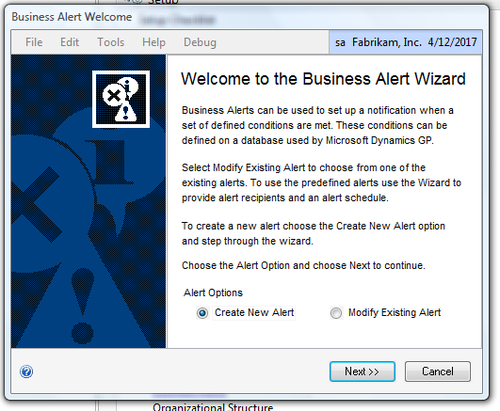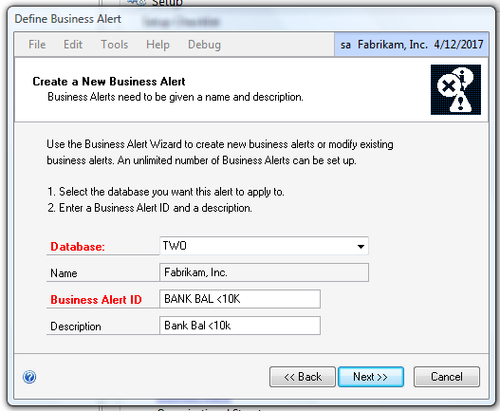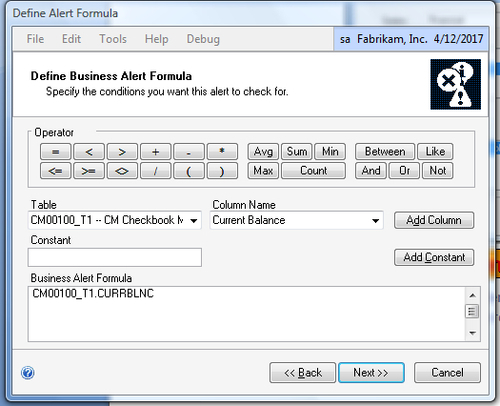It's always nice to find out about problems early.
Early notification usually means that there is still time to fix the
issue. Dynamics GP provides a great mechanism for early warnings in the
form of Business Alerts. Business Alerts allow companies to build a
criteria for notification and then to get notified via e-mail or within
the application. Additionally, a report of information related to the
alert can be sent as a part of the e-mail. A wizard-like interface is
used to set up alerts but these can get very complex.
For this recipe, we'll build a
basic Business Alert with all of the foundational pieces for a more
complicated alert. For our sample business alert we'll assume that a
company would like to be notified when their bank balance falls below
$10,000 to allow them to transfer cash from another account.
Getting ready
Users must be logged in as
'sa' to create business alerts. Log in as 'sa' prior
to starting this recipe.
How to do it...
Let's look at how to build a Business Alert:
1. On the Navigation Pane select Administration. Select Business Alerts under System. In the System Password field enter the system password and click on OK.
2. Leave the Create New Alert option selected and click on Next to start an alert:

3. Select a company database. The company database for the sample company is TWO.
4. Name this alert BANK BAL <10K in the Business Alert ID field.
5. In the Description field type Bank Bal <10k. Click on Next to move on:

6. In the Series field select Financial. Find the CM Checkbook Master table in the Tables menu. Click on it and click on Insert to add this table. Then click on Next to continue:

7. After selecting the appropriate table it's time to define the alert formula. In the Define Alert Formula window select CM00100_T1 - CM Checkbook Master Table. Select Current Balance in the Column Name field and click on Add Column: under

8. Click on the less than (<) button. Type 10000 in the Constant field and click on Add Constant. Click on Next.
9. After the alert criteria have been established it's time to set up the alerts. Click on the E-mail selection next to Send To. Select Message and Report in the Send selection. Enter your e-mail address and click on Insert. In the Message Text area type Bank Account Balance is below $10,000 and click on Next:
9. After the alert criteria have been established it's time to set up the alerts. Click on the E-mail selection next to Send To. Select Message and Report in the Send selection. Enter your e-mail address and click on Insert. In the Message Text area type Bank Account Balance is below $10,000 and click on Next:

10. Finally, we'll lay out the report to accompany the alert. Select the CM00100_T1 - CM Checkbook Master table in the Table field. Scroll down to Checkbook ID in the Columns menu. Select it and click on Insert. Scroll down to Current Balance. Select it and click on Insert. Click on Next to move on:

11. Click on Next past the Select Report Sorting Options window.
12. The Schedule Alert window can be used to adjust the timing of alert deliveries. We'll leave the defaults and click on Finish to wrap up:

How it works...
This process creates a
Business Alert that checks the bank balance in Dynamics GP at every
midnight and e-mails an alert and detailed report if the balance drops
below $10,000. A manager will then get this alert via email or on their
phone and be prepared to move cash even before they leave for the office
in the morning. Business Alerts are extremely useful for checking items
against a threshold. This includes scenarios such as accounts over
budget, checkbook balances below a limit, customers over their credit
limit, inventory items at their reorder point, and payments past due.
This is just a sample of the scenarios that can be created.
There's more...
A great place to start working with Business Alerts is with the included prebuilt alerts.
Prebuilt alerts
Microsoft Dynamics GP comes
with a prebuilt set of common Business Alerts, including alerts for many
of the scenarios described previously and more. Modifying an existing
Business Alert is a great way to learn about the process and move into
creating more complex alerts. When creating a Business Alert simply
select Modify Existing Alert instead of Create New Alert and walk through the wizard.